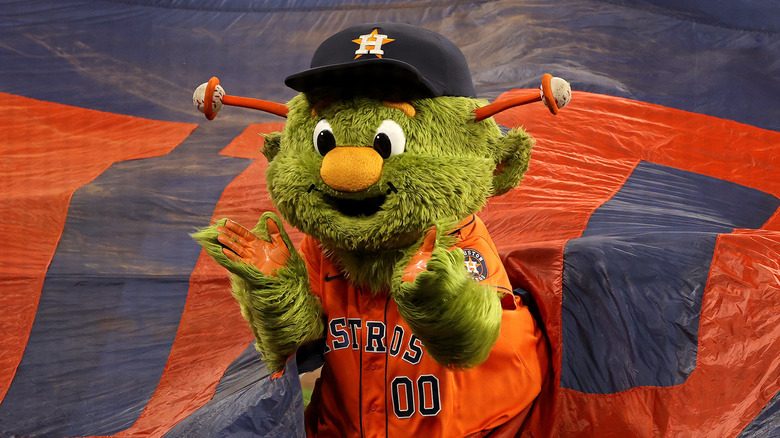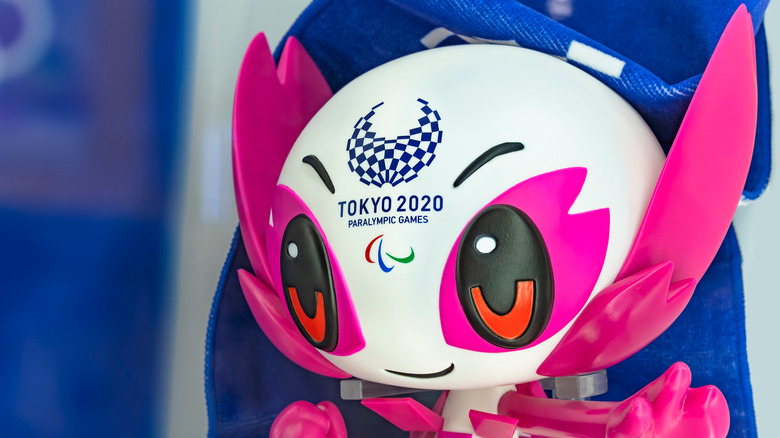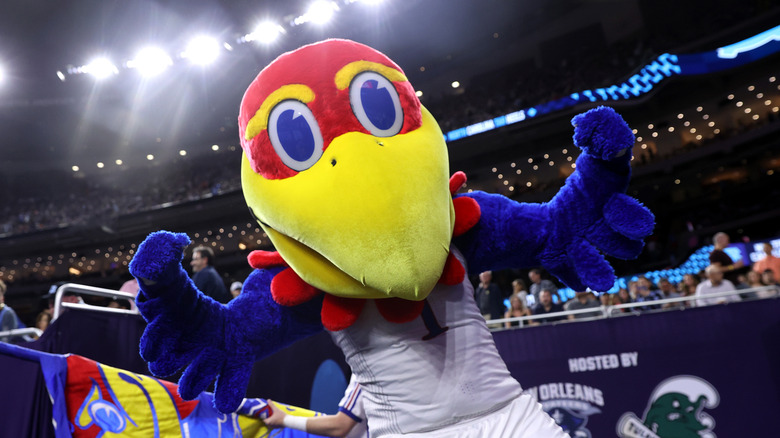The Origin Of The Sports Mascot
As any sports fan will tell you, it's not just a game. It's a way of life, a commitment, a week-in, week-out pledge to follow your team through the worst of runs, and in spite of the most abysmal of final results. Nobody wants to be declared a false fan, or a bandwagoner.
It's an enormous business, all told, and one that's taken very, very seriously. According to Market Watch, U.S. sports fans spent $56 billion dollars supporting their teams in the period from September 2016 to September 2017. This figure reportedly includes refreshments at venues and the cost of travel on top of admission itself. Naturally, teams know this, and unleash a truly staggering array of merchandise to ensure that dedicated fans can rock the team's logo and the names of star players wherever they go. Fans can indeed become walking signs of this dedication, but the true walking personification of a given team's spirit is, of course, the mascot.
A mascot's lot in life is largely to cavort, gambol, and caper for fans' amusement, but not all team mascots are human beings in costumes. Sports mascots have taken various forms throughout their long history.
Mascots were originally lucky charms of sorts
Merriam-Webster defines a mascot as "a person, animal, or object adopted by a group as a symbolic figure especially to bring them good luck." This meaning of the word was reportedly first recorded in 1881. This means that, for more than a century, students have taken lucky mascots to examinations, they have been seen at sports games, and have cropped up everywhere else in between.
According to the Online Etymology Dictionary, it was during the very period reported by Merriam-Webster that the opera "La Mascotte" entered the public consciousness. It features a character that has a way of bringing a mysterious sort of luck in her wake. "Mascotte," according to the resource, is a term from the time that means "sorcerer's charm, 'faerie friend,' good luck piece." By 1881, the opera had reportedly been adapted and played in England, and so the concept of lucky mascots began to spread.
In 1889, Harry Clay Palmer wrote in "Athletic Sports in America, England, and Australia" (via the Online Etymology Dictionary) that mascots had already become a fixture of U.S. sports teams. They could be either animals or people, per Palmer, "so long as his presence upon the players' bench insures a victory — in the minds of the players — to the team with which he has cast his fortunes and in whose favor he exercises the influence he is supposed to have with Dame Fortune."
The legacy of the Clown Prince of Baseball
The Eye states that the idea of lucky mascots fit perfectly with sports, an arena in which players downcast by a losing streak could credit a "lucky'" occurrence with turning things around. A bulldog named Handsome Dan reportedly became the first mascot of a university team in 1889, owned by Yale player Andrew Grave. Handsome Dan's presence may not have had any direct impact on the game, but as long as the players believed the bulldog did, that was, and remains, more than enough.
Later, professional human mascots arose. The most notable early example was Max Patkin, affectionately remembered as the Clown Prince of Baseball. As Patkin's official website reports, he was a minor league pitcher who became a star after an incident at a match in Honolulu. The legendary Joe DiMaggio struck a fantastic hit and Patkin imitated his run around the bases. Patkin's antics struck a chord with the assembled fans; so much so they kicked off a near-constant tour of U.S. ballparks that began in 1944. Patkin was 79 when he sadly died in 1999, per the Independent, having delighted baseball fans for decades.
For millions of fans today, it's difficult to imagine a big sporting event without the customary mascots. They're a draw in themselves, and we have a long line of fantastic performers, from Handsome Dan to the beloved Clown Prince of Baseball himself, to thank for that.


